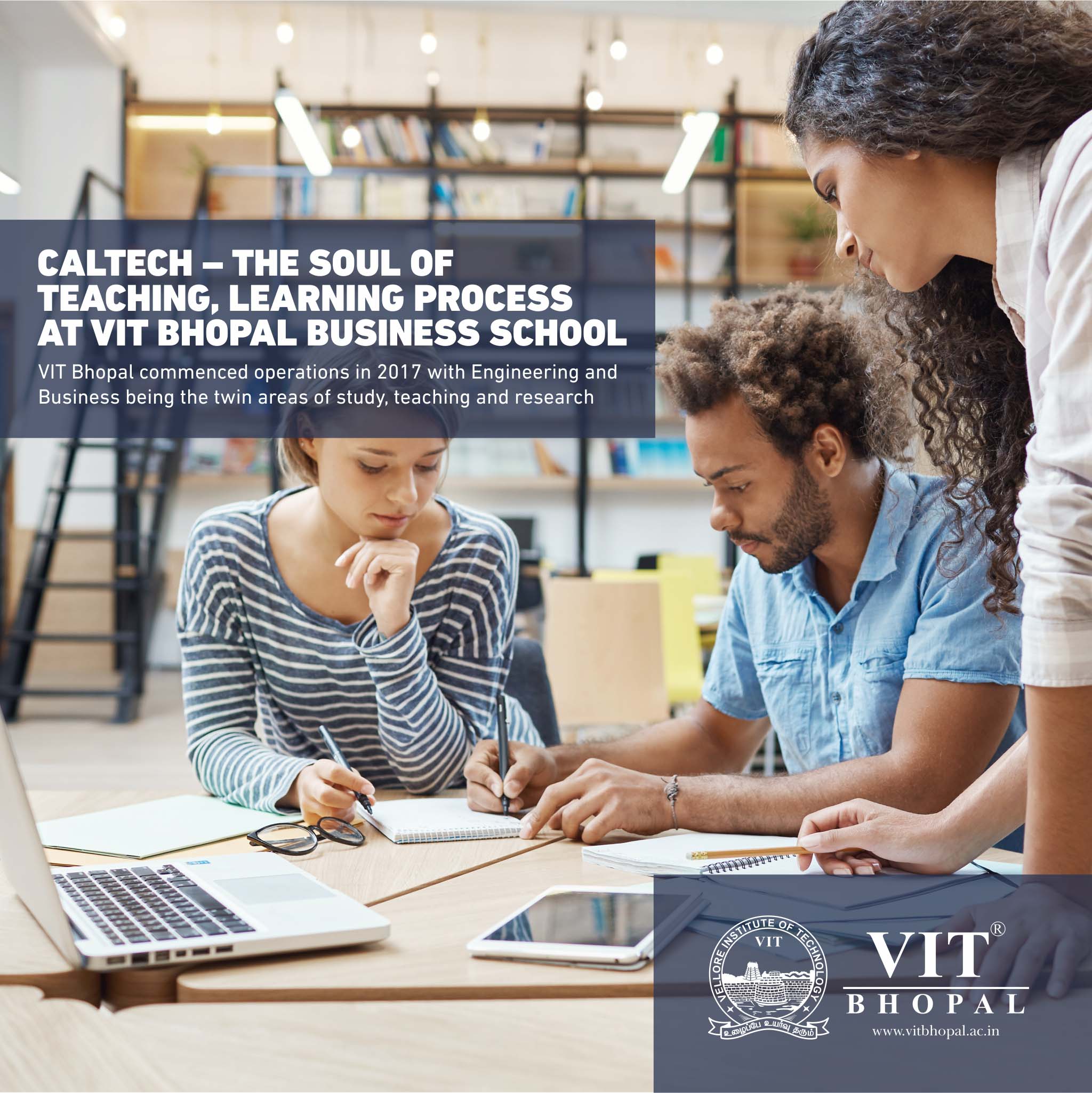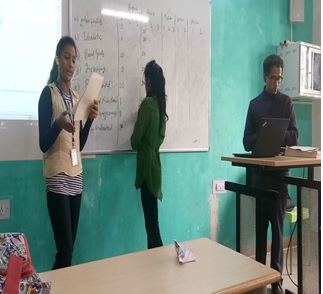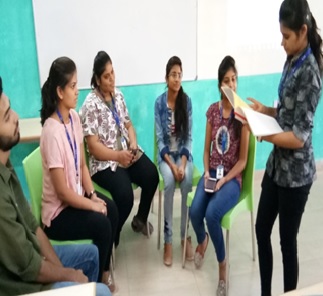CALTech – The soul of teaching, learning process at VIT Bhopal Business School

VIT Bhopal commenced operations in 2017 with Engineering and Business being the twin areas of study, teaching and research. Two of the most important distinctive features of VIT Bhopal are the presence of 100% doctoral faculty and the emphasis on the novel Collaborative Active Learning through Technology- CALTech, as the prime method of teaching learning. The word CALTech is a novel terminology coined by the illustrious Assistant Vice-President, Ms. Kadhambari S Viswanathan. In the education arena it is commonly accepted that peer-to-peer learning is one of the most effective methods of long lasting learning behaviour. This understanding has led to the creation of studio based class-rooms at VIT Bhopal, wherein students are made to sit around round tables in groups of 6 to 7. This enables them to interact in groups, which results in better understanding of the group dynamics, when the teacher gives them a hands-on assignment. The word Collaborative comes from this aspect of the teaching learning method. Students collaborate with each other in the learning process. They also make and deliver presentations at the end of their group assignment which augments their public speaking skills as well.
Traditionally the method of teaching involved the process of the teacher delivering a lecture and the students participating in passive listening only. It has been very well concluded that this process was sub-optimum. Under CALTech the lecturing mode is incorporated for only one third of the total delivery time and makes the students learn by doing things and activities for the remaining two-thirds of the time. Once a student gets involved in doing, his learning is more durable and he is totally engrossed in the entire process for the whole duration of the class. This is a much more effective method of conducting the instruction process. As a result the student here is no more a passive listener but is transformed into an active doer first hand, hence the word Active in the acronym – CALTech. Last but not the least, technology has become ubiquitous in the modern day workspace and education is not an exception in this regard. At the VIT Bhopal Business School faculty are actively encouraged to use technology in their lecture delivery up to the most optimum level. There are tools like Power Points, Moodle, Wifi, Videos, Video-conferencing etc. which have become indispensable in the Business School. This explains the term Tech which implies technology in the acronym CALTech.
While the learning process becomes more engaging and fulfilling for the students in the CALTech process, it places a different set of demands on the faculty to take sessions in this mode. They have to come up with meaningful activities designed to impart to the students, the desired learning outcomes while keeping them thoroughly engrossed and engaged. It is very important that the activities are not disjointed and meaningless. They should flow from one to another in a seamless and smooth manner while being absolutely logical in their sequence. Small activities should form the building blocks of larger and more complex ones. They should lead to a sense of fulfilment in the minds of the students upon successful completion of the tasks. CALTech is such a process of teaching and learning which can be extremely rewarding to both the teacher and the taught. No doubt in the beginning the faculty has to put conscious efforts to train themselves in the CALTech mode but once achieved successfully it is extremely satisfying. At VIT Business school the entire team of the faculty puts all their sincere efforts in imparting knowledge to the students using the CALTech mode of teaching. One can claim that the faculty are using the method in all to its full potential. Some of the activities which are regularly followed at VIT Bhopal Business school, while delivering the lectures using CALTech are outlined below:
- Group Discussion – The instructor outlines a few rudimentary aspects of the content of the lecture and does not present all the facets of the problem at hand. He then assigns time to the student teams for active brainstorming on their part. After this the floor is thrown open for the volleys of points and counter points from the various student teams. The instructor has to be alert and notice the various aspects of the problem which are revealed in this group discussion. He has to be a facilitator and has to summarise the key learnings that come out of this exercise. This puts the entire session in the right perspective.
-
Group Presentation – Each team is assigned a topic related to the content of the lecture. The students are given a challenging time interval to prepare a crisp presentation.
 The time accorded should not be extremely short or extremely long. It should just stretch their capabilities in the right amount. They are able to interact dynamically while preparing their presentations and it helps them in developing inter-personal skills. It is often noticed that in such an exercise a leader naturally emerges from the students and takes command. Other students are also motivated naturally to groom themselves and emerge as leaders in the future.
The time accorded should not be extremely short or extremely long. It should just stretch their capabilities in the right amount. They are able to interact dynamically while preparing their presentations and it helps them in developing inter-personal skills. It is often noticed that in such an exercise a leader naturally emerges from the students and takes command. Other students are also motivated naturally to groom themselves and emerge as leaders in the future. -
Role Play – This activity is one of the most intensely engaging ones and the one which is very effective in life long first hand learning. There is the involvement of two sides in this exercise and can involve either two individuals or two teams. A crystal clear example of this exercise is the role play between a seller and a customer, a waiter and a customer, owner and management, management and workers etc. The key skill which is inculcated in the future managers via this exercise is that of empathy.
 The students are able to imagine themselves to be in the other person’s shoes and think and act according to his viewpoint. It also hones their acting skills and helps them develop self-confidence.
The students are able to imagine themselves to be in the other person’s shoes and think and act according to his viewpoint. It also hones their acting skills and helps them develop self-confidence. - Case-study presentation – Case-study is a teaching method innovation that was pioneered by the Harvard Business School in the US. It recreates a live business situation in the class room in verbal, audio and visual terms. The students are again divided into teams and each of them is presented with the same case-study/caselet. They are given adequate time to discuss the corporate problem presented to them and what are the most effective likely solutions to the same. It is critical to remember that there is no right answer to the problem described in the case-study. Life in the real world is not black or white but it is shades of grey. The interlocutor or the instructor acts as a facilitator in the process and judges the effectiveness of the approaches taken up by the various teams as a solution to the corporate problem situation presented. He uses this tool to outline the various concepts of business and how they are employed in a real-world setting.
- Poster presentation – One of the most graphical methods to get the student involved in the active learning environment being created by the instructor in the class-room. A basic concept of business for example – financial management can be presented to the students. They are then asked to involve themselves in the preparation of a poster depicting the business concept in all its perspectives. This tool enhances the creativity of the students and lends wings to their thought process. They are used to think in boundless terms and employ the tools such as design thinking wherever possible.
- Debate – All practical problem situations always have two opposing viewpoints just like a coin has two opposite sides. Debate is a tool which is based on the above truism. A problem is presented to the two sides. They are given time to organize their thoughts so that they can be presented in the form of a forceful argument to buttress their point either for or against the motion. This tool is extremely effective in developing logical thinking and the power of expressing the individual’s thoughts. It requires thinking on the feet and an extremely agile expression. The public speaking capability is also tested in this exercise/activity.
The above are but a sample of the plethora of creative activities that can be employed in the field of business education while employing the CALTech mode of teaching and learning. At the VIT Business School the faculty are extremely motivated and actively involved in the CALTech method. They have become experts in this arena and leave no stone unturned in their quest for excellence as regards to this novel teaching learning methodology. At VIT Business School the faculty do not rest on their past achievement and believe that excellence is a never-ending process. They continuously work at stretching their boundaries and limits. The faculty are striving every day and are giving their students even-better learning experience every day. Perfection is an ever-elusive term but aiming at it leads to continuous improvement and can help in asymptotically approaching the same.


